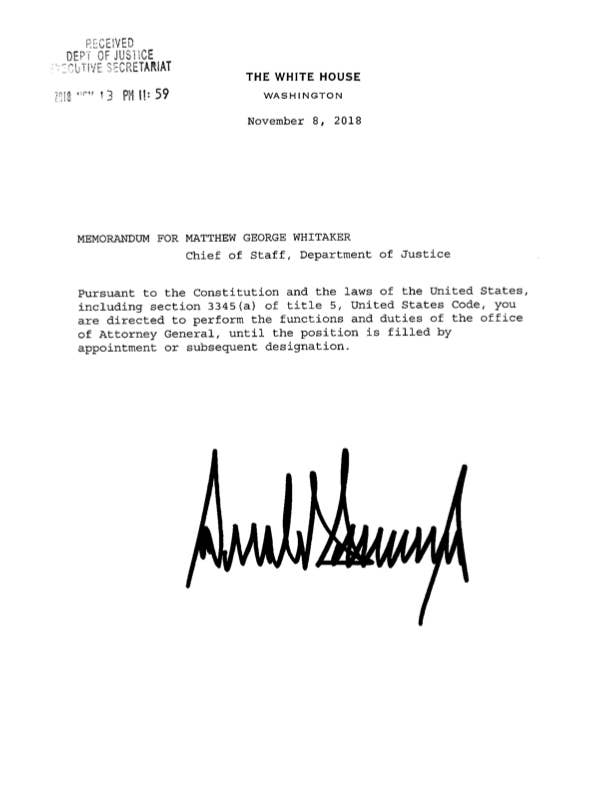
WASHINGTON — A newly released document regarding former acting attorney general Matthew Whitaker’s appointment shows that, at the earliest, President Donald Trump authorized Whitaker to lead the Justice Department a day later than officials previously said was the case.
White House and Justice Department officials previously had repeatedly declined to make public a copy of Trump’s memorandum designating Whitaker the acting attorney general this past November. A copy of the document, obtained by BuzzFeed News in response to a Freedom of Information Act request, suggests why that was the case: The document raises several questions about the timing of and process involved in Whitaker’s appointment.
Then-attorney general Jeff Sessions, whose departure as the head of DOJ was forced by Trump, resigned by way of an undated letter made public Nov. 7, 2018. Trump tweeted that afternoon that Matthew Whitaker, Sessions’ chief of staff, would be taking over as the acting attorney general until a replacement was confirmed.
The obtained presidential memorandum, dated Nov. 8, does not make clear when Sessions’ resignation took effect or when Whitaker actually began serving as acting attorney general.
Whitaker’s appointment was not automatic: Deputy Attorney General Rod Rosenstein would have become the acting attorney general under law by default if Sessions left, but Trump took advantage of another law that allows the president to name certain people as acting officers for a period of time.
Sessions ceremoniously left DOJ early on the evening of Nov. 7, and the Justice Department released a statement from “Acting Attorney General Matt Whitaker” shortly thereafter.
The memorandum signed by Trump appointing Whitaker to the role, however, was not dated until the next day, Nov. 8, and the DOJ’s Executive Secretariat — the office with the “responsibility for controlling and managing correspondence emanating to and from” top DOJ officials — did not mark its receipt of the memorandum until 11:59 p.m. Nov. 13.
Notably, on Nov. 8, Whitaker, along with Homeland Security Secretary Kirstjen Nielsen, issued the asylum rule that preceded Trump’s Nov. 9 move seeking to limit asylum applications from along the southern border.
On the morning of Nov. 14, DOJ released a memorandum supporting the legality of Whitaker’s appointment. In it, the head of the Office of Legal Counsel, Assistant Attorney General Steven Engel, did not provide specifics about the timing of Whitaker’s appointment — only saying that Trump designated Whitaker as acting attorney general “[a]fter” Sessions resigned.
That same day, White House spokesperson Raj Shah used similar language, telling BuzzFeed News, “After accepting the resignation of Attorney General Jeff Sessions, the President signed a memorandum addressed to Matthew Whitaker, directing him to perform the functions and duties of the office of Attorney General, until the position is filled by appointment or subsequent designation.”
The next week, Shah declined to provide a copy of the memorandum or any additional information, writing that it was “relevant to ongoing litigation.” BuzzFeed News subsequently filed a Freedom of Information Act request to obtain the memorandum.
In addition to the big questions of when Sessions’ tenure formally ended and when Whitaker’s formally began, the obtained memorandum also leaves unclear when DOJ was formally notified of Whitaker’s appointment and why the Executive Secretariat’s notation signifies that DOJ did not receive the appointment memorandum until late at night Nov. 13.
Neither a DOJ spokesperson nor White House spokespeople responded to questions about the memorandum and the timing of Sessions’ resignation and Whitaker’s ascension to acting attorney general.


